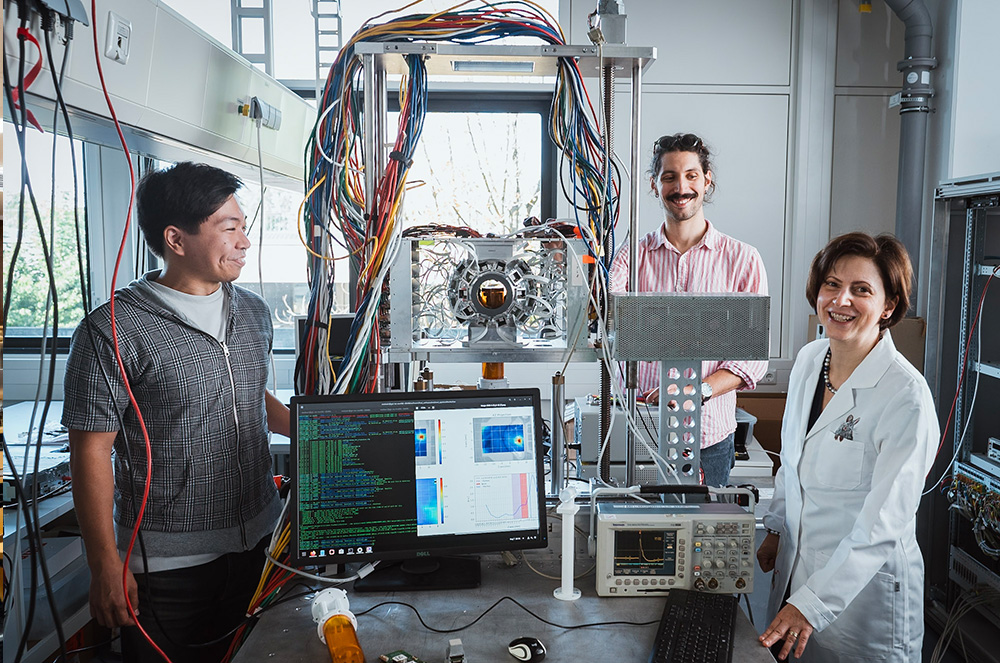Today we celebrate Photonics Day. The science of light and lasers is well on its way to playing a key role in 21st century medicine. Lasers also play an important role in the research activities of Professor Katia Parodi. She holds the Chair of Medical Physics at LMU. Her team is also active at the Centre for Advanced Laser Applications. In a short interview Katia Parodi spontaneously gave us a brief insight into her work and shared her thoughts on how photonics will affect the medicine of the future.
Can you describe how photonics is integrated into your research of medical physics?
Photonics has ubiquitous role in medical physics, including several research directions on pre-clinical and clinical image-guided radiotherapy at our chair. Light-mediated detection processes are central to the scintillation detectors which we use to detect energetic photons in our prototype positron emission tomography and Compton imaging systems for treatment verification and potentially biological guidance in particle therapy. Similarly, we pioneer the use of optical readout techniques in new in-house developed instrumentation exploiting secondary products of ionization induced by heavy charged particles in matter for characterization of pre-clinical and clinical beams.
What role does the laser play in your research?
A dedicated group at our Chair is engaged in utilizing high-power lasers as future sources of various radiation species, offering new opportunities to generate proton and light ion beams with properties distinct from those of conventional radiofrequency-driven accelerators. In particular, for biomedical applications we are intrigued by the possibilities to use optical means for exploration of ultrafast processes relevant to radiation–matter interactions to elucidate phenomena which are not yet fully understood, but might open new avenues for increasing the therapeutic index in radiation therapy.
What are some of the most impactful current uses of photonics in medicine today?
Despite my narrower view in the field of photonics in connection to our main research focus on external beam radiotherapy, I see that photonics plays an increasing key role in several areas of daily healthcare. The increasing relevance of photonics also for the Medical Physics field is reflected by the fact that the 2025 Medical Physics annual congress of the German Medical Physics Society held in Berlin a dedicated joint session together with the German Society for Biophotonics and Lasers in Medicine dedicated to laser technologies in healthcare (see here). In addition to many inspiring insights on exciting new multimodal microscopic and endoscopic developments, the session also highlighted research pursued at the LMU Klinikum in the ‘Laser Forschungslabor’ headed by Prof. Ronald Sroka , where they are pioneering among others the application of intraoperative photodynamic therapy for glioblastoma treatment. And as also stated in our recent Medical Physics School in Bad Honnef (see here) by Prof. Brian Pogue, who led the clinical translation of several medical physics innovations based on optics such as Cherenkov-based in-vivo dosimetry in radiation therapy, “optics is the only imaging tool that routinely covers microscopic to macroscopic imaging”, from probing multispectral biological features to enabling cost effective point of care medicine.
What recent advances in photonics do you think have the potential to significantly impact patient care or diagnostics?
There are several innovations that are pushing photonics from the laboratory into daily clinical practice, promising earlier diagnosis, improved treatment precision, and better patient outcomes. I am particular intrigued by advances in ultrafast and time-resolved optical imaging to probe matter at unprecedented time scales to gain new insights into living systems and underlying mechanisms at the molecular level. And as we do research on ionizing radiation induced acoustic (called also ionoacoustics), I am also following with great interest the progress in the rapidly emerging field of photoacoustics for both diagnostics and therapy. But there is even a wider spectrum of photonics applications at the intersection of medical physics and biomedical engineering that will undoubtedly influence medical practice on a broad scale in several disciplines, from dermatology and ophthalmology to oncology and other areas. These developments are driving progress in image-guided interventions, providing new tools for personalized and minimally invasive diagnostics, as well as powerful laser systems that enable more precise and selective treatments.
Future progress in photonics will undoubtedly also be driven by advances in physics instrumentation and engineering, as well as by the incorporation of artificial intelligence, fostering the development of self-regulating and intelligent systems that will facilitate broader implementation in healthcare.
Interview: Nina Beier & Thorsten Naeser

Pictures: Christoph Hohmann (MCQST)

